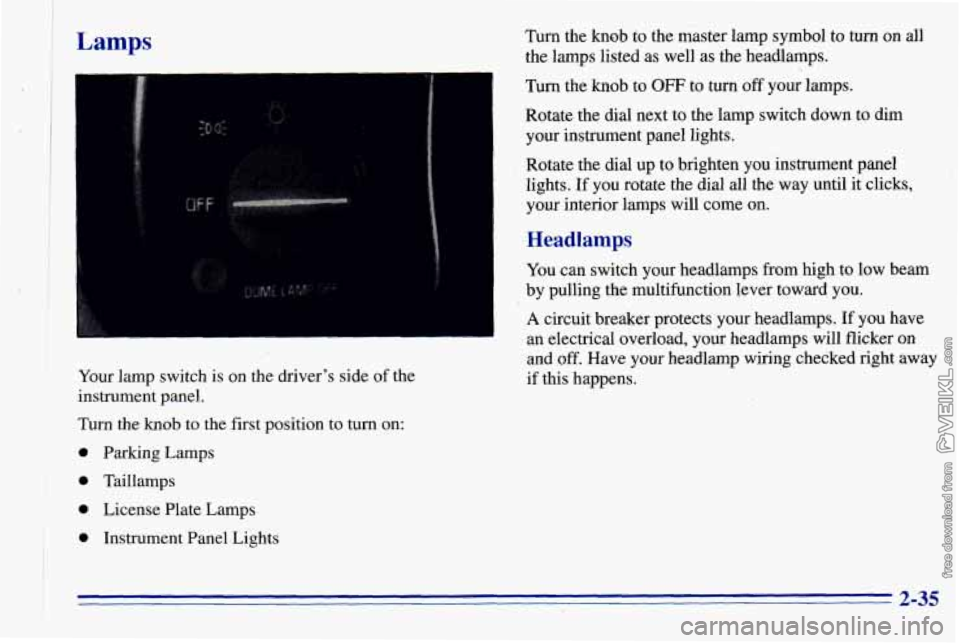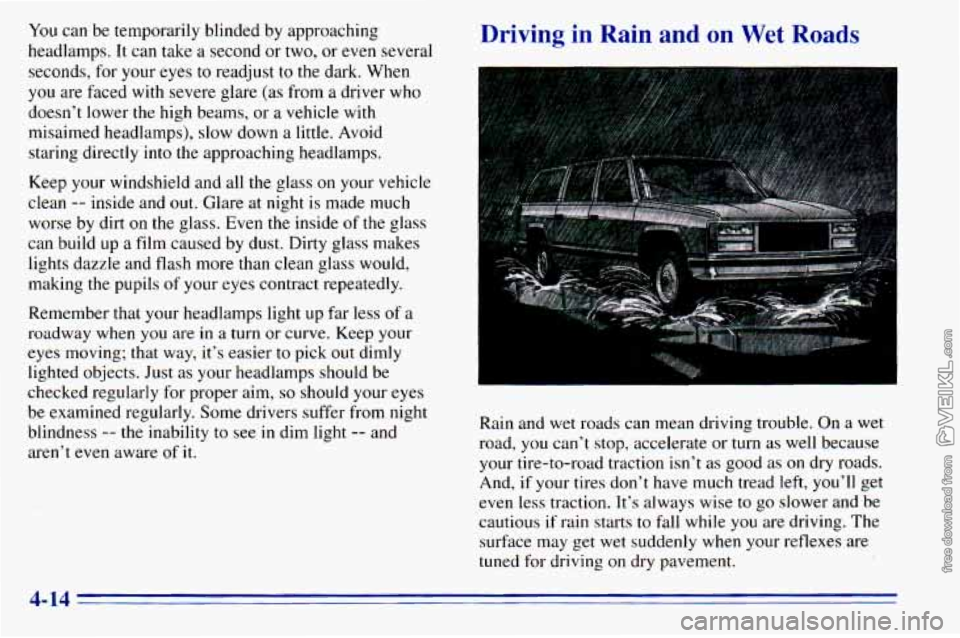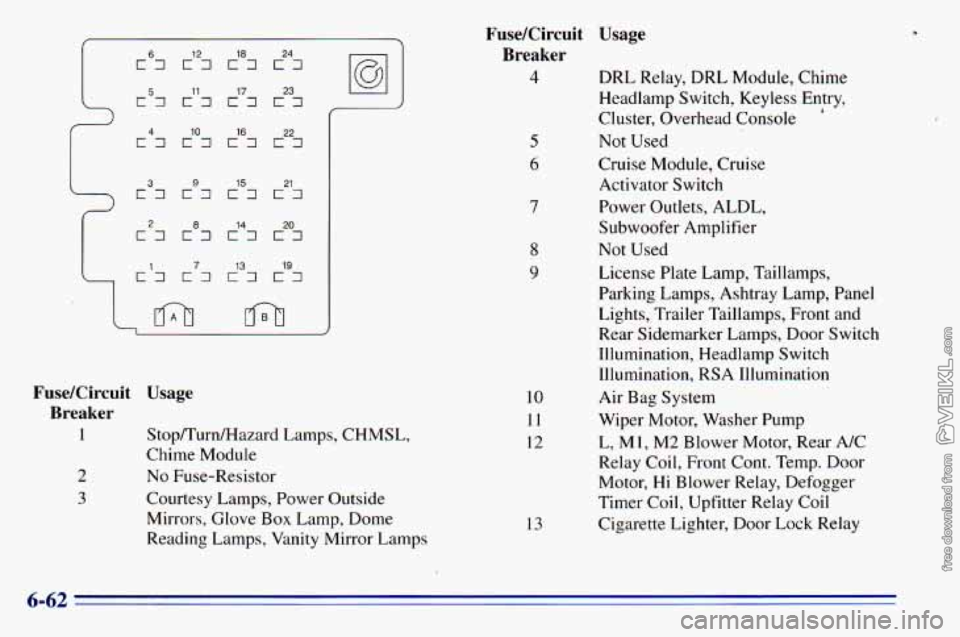1996 CHEVROLET ASTRO lights
[x] Cancel search: lightsPage 7 of 372

Vehicle Symbols
These are some of the symbols you may find on your vehicle.
For example,
these symbols
are used on an
original battery:
POSSIBLE A
CAUTION
INJURY
PROTECT EYES BY
SHIELDING
CAUSTIC
ACID COULD BATTERY
CAUSE
BURNS
SPARK
OR ,111,
COULD FLAME
EXPLODE BATTERY
These symbols are important
for you and
your passengers
whenever your
vehicle
is
driven:
DOOR LOCK
FASTEN SEAT
BELTS
These symbols have
to do with
your lights:
SIGNALS e
TURN
WARNING
A
HAZARD
FLASHER
FOG LAMPS
$0
These symbols are on
some of
your controls:
WIPER w
WINDSHIELD
DEFROSTER
VENTILATING FAN
(
-b
-J
These symbols are used on
warning and
indicator lights:
COOLANT -
TEMP -
CHARGING I-1
BATTERY
SYSTEM
BRAKE
(0)
COOLANT a
ENGINE OIL w,
PRESSURE
ANTI-LOCK
(@)
BRAKES
Here are some
other symbols
you may see:
FUSE
I
LIGHTER n
HORN )a(
SPEAKER
b
FUEL p3
V
Page 95 of 372

1-
,
Lamps
I
I i
i
I
Turn the knob to the master lamp symbol to turn on all
the lamps listed as well as the headlamps.
Turn the
knob to OFF to turn off your lamps.
Rotate the dial next to the lamp switch down to dim
your instrument panel lights.
Rotate the dial up to brighten you instrument panel
lights. If you rotate the dial all the way until it clicks,
your interior lamps will come on.
Headlamps
You can switch your headlamps from high to low beam
by pulling the multifunction lever toward you.
A circuit breaker protects your headlamps. If you have
an electrical overload, your headlamps will flicker on
and off. Have your headlamp wiring checked right away
I Your lamp switch is on the driver's side of the if this happens.
instrument panel.
Turn the
knob to the first position to turn on:
I 0 'parking Lamps ! 0 Taillamps
I * * License Plate Lamps
0 Instrument Panel Lights
* 2-35
Page 113 of 372

Speedometer and Odom. er
Your
speedometer lets you see your speed in both miles
per hour (mph) and kilometers per hour (km/h). Your
odometer shows how far your vehicle has been driven,
in either miles (used in the United States) or kilometers
(used in Canada).
A
Your odometer is tamper resistant. The digital odometer
will read
999,999 if someone tries to turn it back.
You may wonder what happens if your vehicle needs a
new odometer installed.
If the new one can be set to the
mileage total
of the old odometer, then it must be. But if
it can’t, then it’s set at zero, and a label must be put on
the driver’s door to show the old mileage reading when
the new odometer was installed.
Trip Odometer
The trip odometer can tell you how far your vehicle has
been driven since you last set
the trip odometer to zero.
The trip odometer will appear in place
of your regular
odometer when you press the TRIP button.
To reset the trip odometer, press and hold the TRIP
button.
To change back to the regular odometer, press
the TRIP button again.
Warning Lights, Gages and Indicators
This part describes the warning lights and gages that may
be
on your vehicle. The pictures will help you locate them.
Warning lights and gages can signal that something is
wrong before it becomes serious enough to cause
an
expensive repair or replacement. Paying attention to
your warning lights and gages could also save
you or
others from injury.
Warning lights come
on when there may be or is a
problem with one of your vehicle’s functions. As you will
see in the details on the next few pages, some warning
lights come on briefly when
you start the engine just to let
you know they’re working. If you are familiar with this
section, you should not be alarmed when this happens.
Gages can indicate when there may be or is a problem
with
one of your vehicle’s functions. Often gages and
warning lights work together
to let you know when
there’s a problem with your vehicle.
When one of the warning lights comes
on and stays on
when
you are driving, or when one of the gages shows
there may be a problem, check the section that tells you
what to do about
it. Please follow this manual’s advice.
Waiting to do repairs can be costly
-- and even
dangerous.
So please get to know your warning lights
and gages. They’re a big help.
2-53
Page 168 of 372

You can be temporarily blinded by approaching
headlamps. It can take a second or two, or even several
seconds, for your eyes
to readjust to the dark. When
you are faced with severe glare (as from a driver who
doesn’t lower the high beams,
or a vehicle with
misaimed headlamps), slow down a little. Avoid
staring directly into the approaching headlamps.
Keep your windshield and all the glass
on your vehicle
clean
-- inside and out. Glare at night is made much
worse by dirt
on the glass. Even the inside of the glass
can build up a film caused by dust. Dirty glass makes
lights dazzle and flash more than clean glass would,
making the pupils
of your eyes contract repeatedly.
Remember that your headlamps light up far less of a
roadway when you are in a turn or curve. Keep your
eyes moving; that way, it’s easier to pick out dimly
lighted objects. Just as your headlamps should be
checked regularly for proper aim,
so should your eyes
be examined regularly. Some drivers suffer from night
blindness
-- the inability to see in dim light -- and
aren’t
even aware of it.
Driving in Rain and on Wet Roads
L
Rain and wet roads can mean driving trouble. On a wet
road, you can’t stop, accelerate or turn as well because
your tire-to-road traction
isn’t as good as on dry roads.
And,
if your tires don’t have much tread left, you’ll get
even
less traction. It’s always wise to go slower and be
cautious
if rain starts to fall while you are driving. The
surface may get wet suddenly when your reflexes are
tuned for driving on dry pavement.
4-14
Page 255 of 372

What to Use Rear Axle
When to Check and Change Lubricant
Refer to the Maintenance Schedule to determine how
often to check the lubricant and when
to change it. See
“Scheduled Maintenance Services” in the Index.
How to Check Lubricant
If the level is below the bottom of the filler plug hole,
you’ll need to add some lubricant. Add enough lubricant
to raise the level to the bottom of the filler plug hole. Refer
to the Maintenance Schedule to determine what
kind of lubricant
to use. See “Recommended Fluids and
Lubricants” in the Index.
Engine Coolant
The cooling system in your vehicle is filled with new
DEX-COOL (orange-colored, silicate-free) engine
coolant. This coolant is designed to remain in your
vehicle for
5 years or 100,000 miles (166 000 km),
whichever occurs first.
The following explains your cooling system and how to
add coolant when it is low. If
you have a problem with
engine overheating, see “Engine Overheating’’ in
the Index.
A 50/50 mixture of water and the proper coolant for
your vehicle will:
0 Give freezing protection down to -34°F (-37°C).
Give boiling protection up to 265 “F (1 29°C).
0 Protect against rust and corrosion.
Help keep the proper engine temperature.
0 Let the warning lights and gages work as
they should.
6-25
Page 292 of 372

12 18 24
c57 c7 E7 c7 11 17 23
4
c7 c7 E7 E7 10 16 22
3 9 15 21 C7 E7 E7 C7
2
c7 c87 c7 c3 14 20
i
c7 1 7 13 19 c7 c7 c7
FuseKircuit Usage
Breaker
1
2
3
Stop/Turn/Hazard Lamps, CHMSL,
Chime Module
No Fuse-Resistor
Courtesy Lamps, Power Outside Mirrors, Glove Box Lamp, Dome
Reading Lamps, Vanity Mirror Lamps
10
11
12
13
FuseKircuit Usage
Breaker
4 DRL Relay, DRL Module, Chime
Headlamp Switch, Keyless Entry,
Cluster, Overhead Console
Not Used
Cruise Module, Cruise
Activator Switch
Power Outlets, ALDL,
Subwoofer Amplifier
Not Used
License Plate Lamp, Taillamps,
Parking Lamps, Ashtray Lamp, Panel
Lights, Trailer Taillamps, Front and Rear Sidemarker Lamps, Door Switch
Illumination, Headlamp Switch
Illumination, RSA Illumination
Air Bag System
Wiper Motor, Washer Pump
L, M 1, M2 Blower Motor, Rear A/C
Relay Coil, Front Cont, Temp. Door
Motor, Hi Blower Relay, Defogger
Timer Coil, Upfitter Relay Coil
Cigarette Lighter, Door Lock Relay
i
5
6
7
8
9
6-62
Page 365 of 372

Instrumentpanel ............................... 2-50
Brightness Control
.................... i ....... 2-35
Cleaning
.................................... 6-53
Cluster
..................................... 2-52
FuseBlock
.................................. 6-61
Interior Lamps
................................. 2-37 Charging System
........................... 2-55
Check Gages
................................ 2-63
Check Oil
................................... 2-61
Daytime Running Lamps Indicator
............... 2-62
Safety Belt Reminder
..................... 1 - 12. 2-54
Service Engine Soon
.......................... 2-58
Loading Your Vehicle
........................... 4-26 .
J
Locks
ack. Tire .................................... 5-24
Cylinders ................................... 7-42
Jump Starting ................................... 5-2
Door ........................................ 2-5
Key Lock Cylinders Service
..................... 7-42
Keyless Entry System
............................ 2-7
Keys
.......................................... 2-1
Key Lock Cylinder Service ..................... 7-42
PowerDoor
.................................. 2-6
Sliding Door Child Security
..................... 2-10
Steering Column Lock Check
................... 7-44
Lubricants and Fluids
............................ 7-47
Lubrication Service. Body
........................ 7-42
Luggagecarrier
................................ 2-47
Certificationflire
............................. 4-26 Lumbar Controls ................................ 1-2
Service Parts Identification ..................... 6-59
Tire-Loading Information
...................... 4-26
Vehicle Identification Number
................... 6-59
Lamps ........................................ 2-35
Dome
...................................... 2-37
Interior
..................................... 2-37
OnReminder
................................ 2-36
Latches. Seatback ................................ 1-5
Leaving Your Vehicle ............................. 2-6
Leaving Your Vehicle with the Engine Running
....... 2-24
Lighter
....................................... 2-48
Lights
Air Bag Readiness ....................... 1-25. 2-54
Anti-Lock Brake System Warning
............ 2-57. 4-6
Brake System Warning
......................... 2-57 Maintenance.
Normal Replacement Parts
........... 6-69
Maintenance Record
............................ 7-49
Maintenance Schedule
............................ 7-1
Long Trip/Highway Definition
................... 7-5
Long TripMighway Intervals
..................... 7-5
Owner Checks and Services
..................... 7-41
Periodic Maintenance Inspections
................ 7-45
Recommended Fluids and Lubricants
............. 7-47
Scheduled Maintenance Services
.................. 7-2
Short Trip/City Definition
....................... 7-4
Short Trip/City Intervals ........................ 7-4
Maintenance. Underbody ......................... 6-X
9-5
Page 370 of 372

warning Devices ........................... 5-1
Warning Lights. Gages and Indicators ............... 2-53
Washer Fluid. Windshield
........................ 6-3 1
Washing Your Vehicle ........................... 6-54
Weatherstrips
.................................. 6-54
Wheel Alignment
.................................. 6-47
Nut Torque
............................. 5-33. 6-67
Replacement
................................. 6-47
Wrench
..................................... 5-25
Windows
..................................... 2-27
Express-Down
............................... 2-28
Power
...................................... 2-27
Swing-Out
.................................. 2-28 Windshield Washer
............................. 2-31
Fluid
....................................... 6-31
Fluid Level Check
............. .............. 7-41
Rear
....................................... 2-32
Windshield Wipers
.............................. 2-31
Blade Replacement
........................... 6-42
Fuses
...................................... 6-60
Rear ....................................... 2-32
Winter Driving
................................. 4-22
Wiring. Headlamp
.............................. 6-60
WreckerTowing
................................. 5-6
Wrench. Wheel
................................. 5-25
9-10